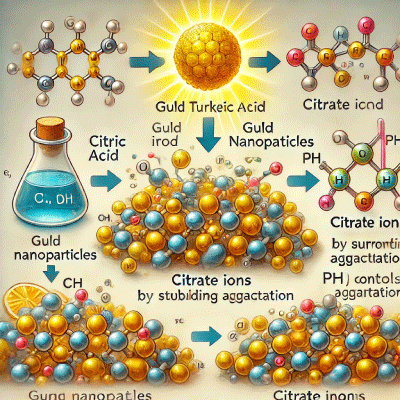The Role of Citric Acid in Gold Nanoparticle Synthesis
Gold nanoparticles (AuNPs) have become a cornerstone in nanotechnology, with applications ranging from medical diagnostics to materials science. One of the most common methods for producing gold nanoparticles is the Turkevich method, where citric acid plays a crucial role in the synthesis process. In this article, we'll explore the multiple roles that citric acid plays in the formation of gold nanoparticles.

1. Reducing Agent
Citric acid serves as a mild reducing agent in the synthesis of gold nanoparticles. During the reaction, citric acid reduces gold ions (Au³⁺) from chloroauric acid (HAuCl₄) to neutral gold atoms (Au⁰). This reduction is essential for the nucleation process, where gold atoms cluster together to form nanoparticles. Without the reducing action of citric acid, gold ions would remain in solution, and nanoparticle formation would not occur.
2. Stabilizing Agent (Capping Agent)
Once the gold nanoparticles are formed, citric acid acts as a stabilizing agent, or capping agent, by adsorbing onto the surface of the nanoparticles. The citrate ions (the deprotonated form of citric acid) attach to the surface, imparting a negative charge to the nanoparticles. This negative charge creates electrostatic repulsion between particles, preventing them from aggregating (clumping together). The stabilization provided by citric acid is key to producing uniformly sized, stable colloidal gold nanoparticles.
3. pH Control
Citric acid also plays a role in controlling the pH of the reaction mixture. The pH of the solution influences the size and shape of the nanoparticles produced. For instance, lower pH levels can lead to the formation of smaller nanoparticles, while higher pH levels can result in larger particles. By adjusting the concentration of citric acid, the pH can be fine-tuned to optimize the synthesis process for specific applications.
Conclusion
Citric acid is indispensable in the Turkevich method for synthesizing gold nanoparticles. It functions as a reducing agent, stabilizing agent, and pH buffer, all of which are essential for controlling the formation, size, and stability of the nanoparticles. Understanding these roles allows for better control over the synthesis process, leading to high-quality gold nanoparticles for various technological and scientific applications.
For more information, visit Nanopartz™ or contact us directly

